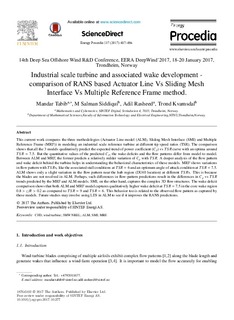| dc.contributor.author | Tabib, Mandar | |
| dc.contributor.author | Siddiqui, Muhammad Salman | |
| dc.contributor.author | Rasheed, Adil | |
| dc.contributor.author | Kvamsdal, Trond | |
| dc.date.accessioned | 2017-12-19T08:58:14Z | |
| dc.date.available | 2017-12-19T08:58:14Z | |
| dc.date.created | 2017-12-17T16:37:15Z | |
| dc.date.issued | 2017 | |
| dc.identifier.citation | Energy Procedia. 2017, 137 487-496. | nb_NO |
| dc.identifier.issn | 1876-6102 | |
| dc.identifier.uri | http://hdl.handle.net/11250/2472709 | |
| dc.description.abstract | This current work compares the three methodologies (Actuator Line model (ALM), Sliding Mesh Interface (SMI) and Multiple Reference Frame (MRF)) in modeling an industrial scale reference turbine at different tip speed ratios (TSR). The comparison shows that all the 3 models qualitatively predict the expected trend of power coefficient (Cp) vs TSR curve with an optima around TSR ≈ 7.5. But the quantitative values of the predicted Cp, the wake deficits and the flow patterns differ from model to model. Between ALM and MRF, the former predicts a relatively milder variation of Cp with TSR. A deeper analysis of the flow pattern and wake deficit behind the turbine helps in understanding the behavioral characteristics of these models. MRF shows variations in flow pattern with TSRs, like the associated stall conditions at TSR = 6 and an optimum angle of attack condition at TSR = 7.5. ALM shows only a slight variation in the flow pattern near the hub region (DU40 location) at different TSRs. This is because the blades are not resolved in ALM. Perhaps, such differences in flow-pattern predictions result in the differences in Cp vs TSR trends predicted by the MRF and ALM models. SMI, on the other hand, captures the complex 3D flow structures. The wake deficit comparison shows that both ALM and MRF model captures qualitatively higher wake deficit at TSR = 7.5 in the core wake region 0.8 > z/R > 0.2 as compared to TSR = 9 and TSR = 6. This behavior too is related to the observed flow pattern as captured by these models. Future studies may involve using LES in ALM to see if it improves the RANS predictions. | nb_NO |
| dc.language.iso | eng | nb_NO |
| dc.publisher | Elsevier | nb_NO |
| dc.rights | Attribution-NonCommercial-NoDerivatives 4.0 Internasjonal | * |
| dc.rights.uri | http://creativecommons.org/licenses/by-nc-nd/4.0/deed.no | * |
| dc.title | Industrial scale turbine and associated wake development -comparison of RANS based Actuator Line Vs Sliding Mesh Interface Vs Multiple Reference Frame method | nb_NO |
| dc.type | Journal article | nb_NO |
| dc.type | Peer reviewed | nb_NO |
| dc.description.version | publishedVersion | nb_NO |
| dc.source.pagenumber | 487-496 | nb_NO |
| dc.source.volume | 137 | nb_NO |
| dc.source.journal | Energy Procedia | nb_NO |
| dc.identifier.doi | 10.1016/j.egypro.2017.10.377 | |
| dc.identifier.cristin | 1528528 | |
| dc.relation.project | Norges forskningsråd: 216465 | nb_NO |
| dc.description.localcode | © 2017 The Author(s). Published by Elsevier Ltd. This is an open access article under the CC BY-NC-ND license (http://creativecommons.org/licenses/by-nc-nd/4.0/). | nb_NO |
| cristin.unitcode | 194,63,15,0 | |
| cristin.unitname | Institutt for matematiske fag | |
| cristin.ispublished | true | |
| cristin.fulltext | original | |
| cristin.qualitycode | 1 | |

